 |
 |
|
 |
 |
Japan: Tokiwa Seiki: 1955-1965?:
Tokiwa Seiki: Pentaflex and Firstflex
Tokiwa Seiki, known as a camera producer in the 50s, was probably a descendant from other companies before WW II. Some sources say they were branched from Kuribayashi, who went on to produce Petri branded cameras. The main model from Tokiwa was called
Firstflex. This name occurred on a TLR camera from 1954, a rather successful one. But in 1955, they produced what seems to be Japan's first penta mirror SLR, the Pentaflex, in very limited numbers. For an explanation of penta mirror, see Some definitions:.That camera is hardly known to the public. In 1958, Tokiwa presented the Firstflex 35, an SLR camera with very special characteristics. A successor of this was distributed
in the UK into the second half of the 60s under the name Plusflex. Last year of production of the Tokiwa 35 slr's was probably 1965. Read more about the Pentaflex under PP SLR
1955-1959
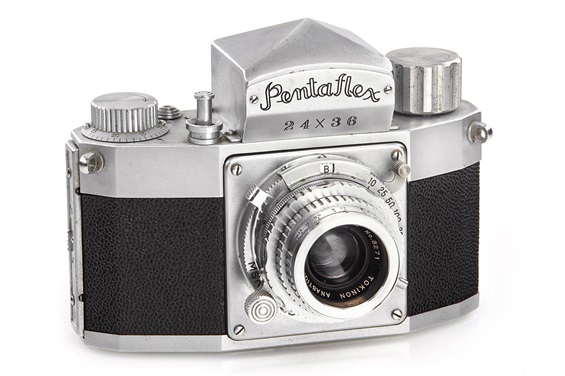 This is a picture of a living Tokiwa Seiki Pentaflex of spring 1955. It had a central shutter behind the lens, otherwise one can recognize the prism house and the shape of the body of the East-German Exakta from 1950. Was it a pentaprism or Porroprism type? Well, neither of them, but a penta mirror construction. To understand the difference between penta prism and penta mirror, please see the chapter Some Definitions.
The prism house wears almost the exact shape of the one on the Ihagee Exakta of 1950, which was a pentaprism. Even the letters had the same font. Tokiwa Seiki had had time to copy it, but chose the somewhat simpler and less expensive mirror version. The mirror house was put on top of the waist level camera house that was released the same year. But it was not interchangeable, as the Exakta was.
Sorry, but this camera is not a part of my collection.
This is a picture of a living Tokiwa Seiki Pentaflex of spring 1955. It had a central shutter behind the lens, otherwise one can recognize the prism house and the shape of the body of the East-German Exakta from 1950. Was it a pentaprism or Porroprism type? Well, neither of them, but a penta mirror construction. To understand the difference between penta prism and penta mirror, please see the chapter Some Definitions.
The prism house wears almost the exact shape of the one on the Ihagee Exakta of 1950, which was a pentaprism. Even the letters had the same font. Tokiwa Seiki had had time to copy it, but chose the somewhat simpler and less expensive mirror version. The mirror house was put on top of the waist level camera house that was released the same year. But it was not interchangeable, as the Exakta was.
Sorry, but this camera is not a part of my collection.
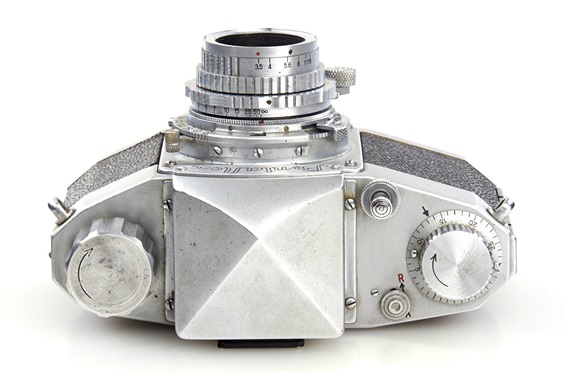 The controls on the top plate were mostly as usual: winder knob to the far right with frame counter on a dial underneath, shutter release button on the far front. And, a bit unusual, the rewind opening button, marked with the red R. No shutter time dial, as that was on the lens. To the left was only a big rewind knob. Also note the shape of the camera house, looking very much like the Exakta. The controls, however, were not as sophisticated as on the East-German model.
The controls on the top plate were mostly as usual: winder knob to the far right with frame counter on a dial underneath, shutter release button on the far front. And, a bit unusual, the rewind opening button, marked with the red R. No shutter time dial, as that was on the lens. To the left was only a big rewind knob. Also note the shape of the camera house, looking very much like the Exakta. The controls, however, were not as sophisticated as on the East-German model.
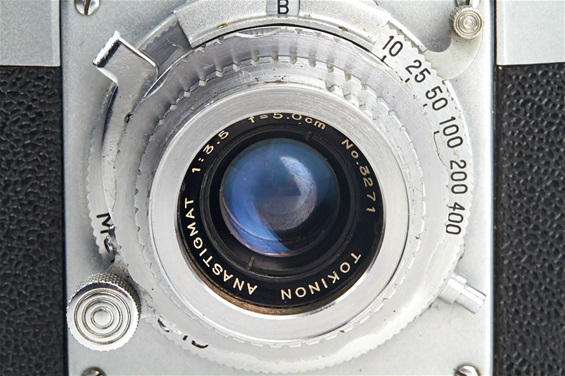 This Tokinon Anastigmat 50/3,5 lens was of central leaf shutter design, like many German and a few Japanese cameras of the 50's. The built-in shutter is an MSK Rapid. Some cameras came with Soligor Anastigmat, probably the same lens.
This Tokinon Anastigmat 50/3,5 lens was of central leaf shutter design, like many German and a few Japanese cameras of the 50's. The built-in shutter is an MSK Rapid. Some cameras came with Soligor Anastigmat, probably the same lens.
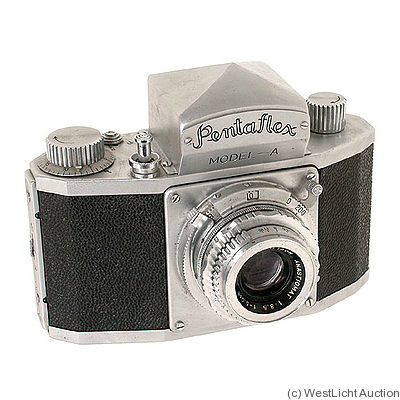 This is a later version, the Model-A. The same lens, but branded Soligor Anastigmat. The only visible change from the first model is the smaller rewind knob.
This is a later version, the Model-A. The same lens, but branded Soligor Anastigmat. The only visible change from the first model is the smaller rewind knob.
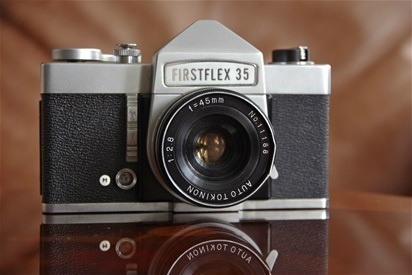 The Tokiwa Firstflex 35 was introduced in 1958, four years after Tokiwa presented their twin lens reflex with the same name, and three years after the almost unknown Pentaflex. This was a remarkable construction: the mirror worked as a shutter, giving light to the film in 1/125 of a second, the only shutter time except for the B! The long switch on the front panel, under the shutter release button, was to be pushed up for 1/125 and down for B. The M plug is for bulb flash. At the other side of the lens is the lens release handle, inherited from Exacta. (And Topcon.) Size: 143x91x48 mm. Weight: 654 grams. Sn. of camera: 67417.
The Tokiwa Firstflex 35 was introduced in 1958, four years after Tokiwa presented their twin lens reflex with the same name, and three years after the almost unknown Pentaflex. This was a remarkable construction: the mirror worked as a shutter, giving light to the film in 1/125 of a second, the only shutter time except for the B! The long switch on the front panel, under the shutter release button, was to be pushed up for 1/125 and down for B. The M plug is for bulb flash. At the other side of the lens is the lens release handle, inherited from Exacta. (And Topcon.) Size: 143x91x48 mm. Weight: 654 grams. Sn. of camera: 67417.
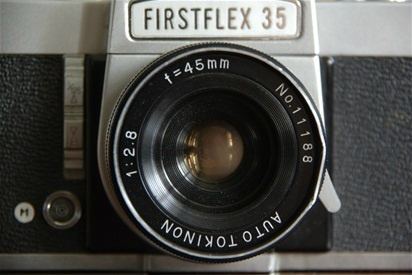 The Auto Tokinon 45/2,8 was among the few standard lenses offering a wider angle than 50mm. sn. 11188.
The Auto Tokinon 45/2,8 was among the few standard lenses offering a wider angle than 50mm. sn. 11188.
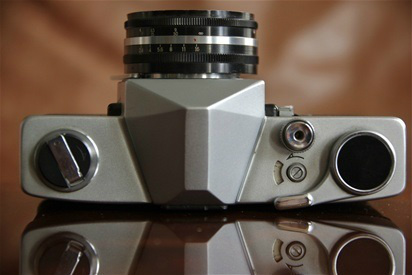 As the shutter time setting was done with the switch on the front, the layout on the top was elegantly simple: rewinder arm to the right, shutter release button in front, frame counter right behind and rewind crank to the left. The Firstflex 2, as this camera is sometimes called, after the TLR Firstflex of '54, was produced only for a short time. A third model, often seen as Plusflex, reconstructed with more shutter time options, was sold in GB until the mid-60s.
As the shutter time setting was done with the switch on the front, the layout on the top was elegantly simple: rewinder arm to the right, shutter release button in front, frame counter right behind and rewind crank to the left. The Firstflex 2, as this camera is sometimes called, after the TLR Firstflex of '54, was produced only for a short time. A third model, often seen as Plusflex, reconstructed with more shutter time options, was sold in GB until the mid-60s.
|
|
 |
|
|
|